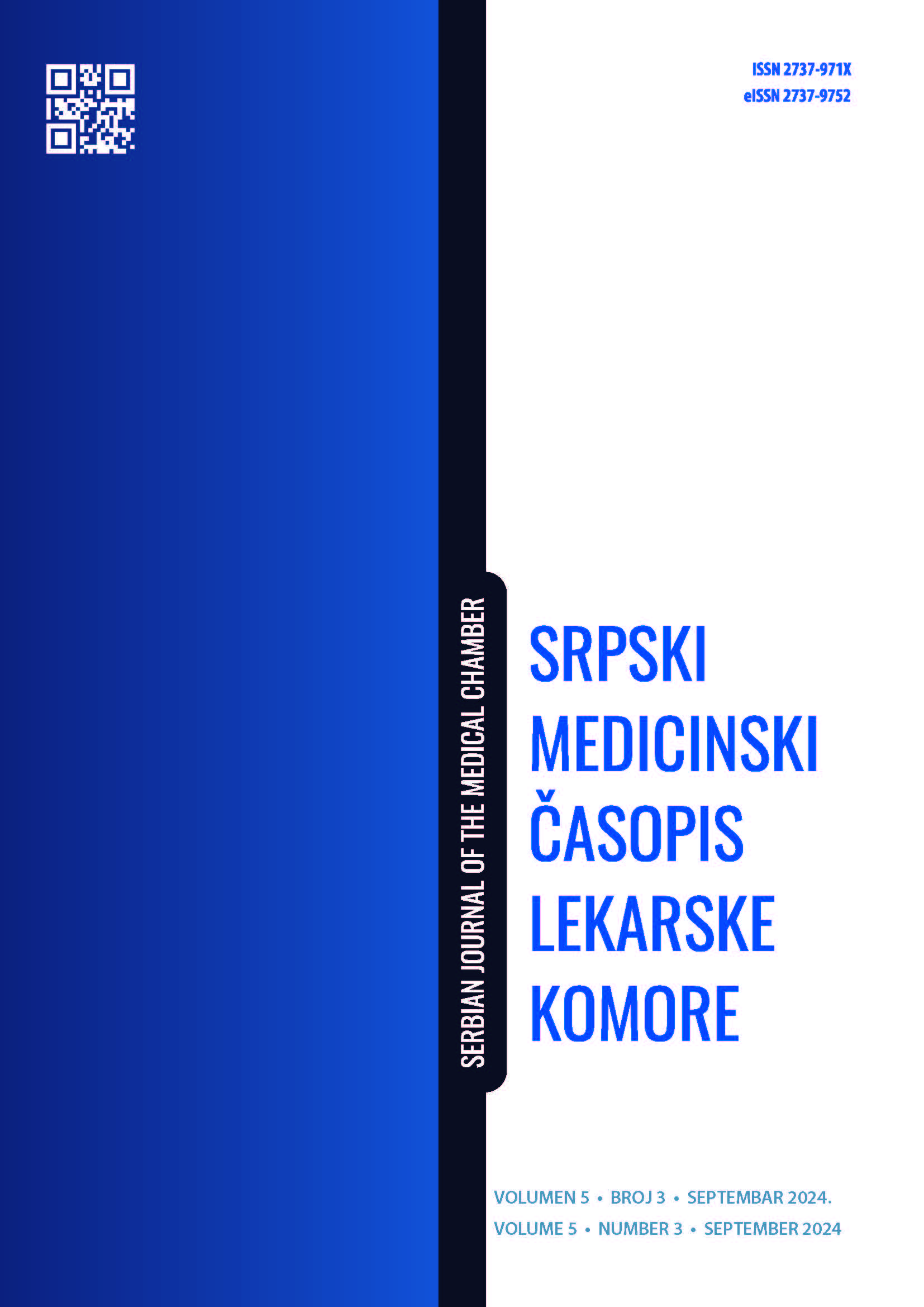THE INFLUENCE OF INSULIN RESISTANCE ON THERAPEUTIC RESPONSE IN NEWLY DIAGNOSED PATIENTS WITH MULTIPLE MYELOMA
Abstract
Introduction: According to the results of previous research, it was found that the dysfunction of the insulin-like growth factor (IGF) system, which is the basis of insulin resistance with hyperinsulinemia, acts as a proliferative tumor factor, and its neoplastic potential is also exhibited in multiple myeloma.
Study aim: The study aims to determine whether there is an association between insulin resistance in patients newly diagnosed with multiple myeloma (NDMM) and the achieved therapeutic response after induction chemotherapy.
Materials and methods: The prospective study included 35 NDMM patients (60% women and 40% men), treated at the Clinical Center of Vojvodina Clinic for Hematology. Glycemia and insulinemia levels were determined after fasting and postprandially, upon which the values of HOMA-IRIf (after fasting) and HOMA-IRIpp (postprandially) were calculated. HOMA-IRI values > 2.2 were the criteria for insulin resistance. The analyses were performed twice – before the initial chemotherapy and after the completion of the treatment. The therapeutic response was evaluated according to the criteria of the Serbian Myeloma Group (SMG) and the International Myeloma Working Group IMWG). Statistical analyses were performed in the SPSS program, Version 22.
Results: The average patient age was 63.85 years. In total, 86% of patients responded favorably to the therapy. The average value of HOMA-IRIf before treatment was 1.82 ± 0.79 and it was 1.80 ± 0.72 after therapy. The central median value of HOMA-IRIpp before treatment was 5.46, with an interquartile range of 1.07 – 20.57, and after treatment, it was 5.86 with an interquartile range of 1.22 – 28.22. A significant negative correlation between HOMA-IRIf after applied treatment and achieved therapeutic response was observed, (p = 0.040).
Conclusion: Active concomitant therapy of insulin resistance in NDMM could improve the response to applied antimyeloma treatment.
References
Albagoush SA, Shumway C, Azevedo AM. Multiple myeloma [Internet]. 2023. [Cited: Jun 30, 2024]. Available from: https://www.ncbi.nlm.nih.gov/books/NBK534764/
Ludwig H, Novis Durie S, Meckl A, Hinke A, Durie B. Multiple myeloma incidence and mortality around the globe; interrelations between health access and quality, economic resources, and patient empowerment. Oncologist. 2020 Sep;25(9):e1406-e13. doi: 10.1634/theoncologist.2020-0141.
Janjić D, Suvajdžić-Vuković N, Popović S, Mihaljević B, Marisavljević D, Elezović I, et al. Klinička hematologija. Beograd: Zavod za udžbenike; 2012.
Bila J. Multipli mijelom: dijagnostički i terapijski vodič. 5th ed. Beograd: Medicinski fakultet Univerziteta u Beogradu; 2022.
Lebovitz HE, Banerji MA. Treatment of insulin resistance in diabetes mellitus. Eur J Pharmacol. 2004 Apr 19;490(1-3):135-46. doi: 10.1016/j.ejphar.2004.02.051.
Arcidiacono B, Iiritano S, Nocera A, Possidente K, Nevolo MT, Ventura V, et al. Insulin resistance and cancer risk: an overview of the pathogenetic mechanisms. Exp Diabetes Res. 2012;2012:789174. doi: 10.1155/2012/789174.
Shushanov SS, Kalinina AA, Kravtsova TA, Sherbakov AM, Chernykh YB, Akentieva NP. Dual effect exhibited by insulin in myeloma and lymphoblastoid cells. Biointerface Research in Applied Chemistry. 2022;12(3):2715-28. doi: 10.33263/BRIAC123.27152728.
Tresaco B, Bueno G, Pineda I, Moreno LA, Garagorri JM, Bueno M. Homeostatic model assessment (HOMA) index cut-off values to identify the metabolic syndrome in children. J Physiol Biochem. 2005 Jun;61(2):381-8. doi: 10.1007/BF03167055.
Horáková D, ŠtěpánekL, Janout V, Janoutová J, Pastucha D, Kollárová H. Optimal homeostasis model assessment of insulin resistance (HOMA-IR) cut-offs: a cross-sectional study in the Czech population. Medicina (Kaunas). 2019 May 17;55(5):158. doi: 10.3390/medicina55050158.
Garderet L, D'Souza A, Jacobs P, van Biezen A, Schönland S, Kroeger N, et al. Response assessment in myeloma: Practical manual on consistent reporting in an era of dramatic therapeutic advances. Biol Blood Marrow Transplant. 2017 Jul;23(7):1193-202. doi: 10.1016/j.bbmt.2017.03.009.
Talia C, Connolly L, Fowler PA. The insulin-like growth factor system: A target for endocrine disruptors? Environ Int. 2021 Feb;147:106311. doi: 10.1016/j.envint.2020.106311.
Bieghs L, Johnsen HE, Maes K, Menu E, Van Valckenborgh E, Overgaard MT, et al. The insulin-like growth factor system in multiple myeloma: diagnostic and therapeutic potential. Oncotarget. 2016 Jul 26;7(30):48732-52. doi: 10.18632/oncotarget.8982.
Gavriatopoulou M, Paschou SA, Ntanasis-Stathopoulos I, Dimopoulos MA. Metabolic disorders in multiple myeloma. Int J Mol Sci. 2021 Oct 22;22(21):11430. doi: 10.3390/ijms222111430.
Tanaka Y, Okabe S, Tauchi T, Ito Y, Ohyashiki K. Targeting insulin-like growth factor in multiple myeloma: novel strategies in the treatment of proteasome inhibitor resistant cells. Blood. 2018;132(Suppl 1):5155. doi: 10.1182/blood-2018-99-114750.
Bost F, Sahra IB, Le Marchand-Brustel Y, Tanti JF. Metformin and cancer therapy. Curr Opin Oncol. 2012 Jan;24(1):103-8. doi: 10.1097/CCO.0b013e32834d8155.
Sélénou C, Brioude F, Giabicani E, Sobrier ML, Netchine I. IGF2: development, genetic and epigenetic abnormalities. Cells. 2022 Jun 10;11(12):1886. doi: 10.3390/ cells11121886.
Gao L, Li L, Hu J, Li G, Zhang Y, Dai X, et al. Metformin inhibits multiple myeloma serum-induced endothelial cell thrombosis by down-regulating miR-532. Ann Vasc Surg. 2022 Sep;85:347-57.e2. doi: 10.1016/j.avsg.2022.04.035.
Arcaro A. Targeting the insulin-like growth factor-1 receptor in human cancer. Front Pharmacol. 2013 Mar 22;4:30. doi: 10.3389/fphar.2013.00030.
Lamhamedi-Cherradi SE, Menegaz BA, Ramamoorthy V, Vishwamitra D, Wang Y, Maywald RL, et al. IGF-1R and mTOR blockade: novel resistance mechanisms and synergistic drug combinations for Ewing sarcoma. J Natl Cancer Inst. 2016 Aug 30;108(12):djw182. doi: 10.1093/jnci/djw182.
Sprynski AC, Hose D, Kassambara A, Vincent L, Jourdan M, Rossi JF, et al. Insulin is a potent myeloma cell growth factor through insulin/IGF-1 hybrid receptor activation. Leukemia. 2010 Nov;24(11):1940-50. doi: 10.1038/leu.2010.192.
Boursi B, Mamtani R, Yang YH, Weiss BM. Impact of metformin on the progression of MGUS to multiple myeloma. Leuk Lymphoma. 2017 May;58(5):1265-67. doi: 10.1080/10428194.2016.1236375.
Papachristou S, Popovic DS, Papanas N. Reduced progression of monoclonal gammopathy of undetermined significance to multiple myeloma in type 2 diabetes mellitus: will metformin never stop its pleasant surprises? Adv Ther. 2022 Jun;39(6):2283-6. doi: 10.1007/s12325-022-02125-1.
National Library of Medicine (NIH). National Center for Biotechnology Information. Investigation of metformin for the prevention of progression of precursor multiple myeloma [Internet]. 2024 [cited 2024 Jul 3]. Available from: https://clinicaltrials.gov/ct2/show/NCT04850846

